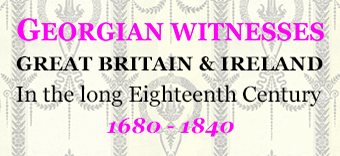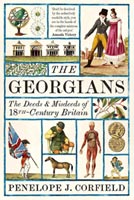Georgian Witnesses
2 / TESTAMENTS TO GEORGIAN TRAVEL IN LITERATURE AND IN MONUMENTS TO IMMIGRATION AND EMIGRATION
NINE TRAVELOGUES
2.1 Edward Cooke, A Voyage to the South Sea and Round the World (1712) – recounting, among much else, the ordeal of Alexander Selkirk, marooned on an uninhabited island in the Juan Fernández islands in the South Pacific.
2.2 Daniel Defoe, The Life and Strange Surprizing Adventures of Robinson Crusoe (1719) – a superb and justly famous imaginative reconstruction of an ordeal, written in autobiographical style, like the real-life one of Alexander Selkirk. The story’s location is imaginary but, in tribute, one of the Juan Fernández islands was in 1966 renamed Robinson Crusoe Island.
2.3 Jonathan Swift, Travels into Several Remote Nations of the World, by Lemuel Gulliver … rapidly known as Gulliver’s Travels (1726) – a masterpiece of fantasy-travel, laced with pointed satire, again in autobiographical style, offering immediacy and impact. The first of the four journeys, to Lilliputia, quickly became the most famous, appearing in special editions for children such as Anon., The Lilliputian Masquerade (1783).
2.4 Lady Mary Wortley Montagu, Turkish Embassy Letters, ed. Anita Desai (1993), a vivid account of Turkish daily life and culture, as relayed to friends and acquaintances by Wortley Montagu, who accompanied her husband in 1716 when he was appointed British Ambassador at the court of the Ottoman Emperor.
2.5 Tobias Smollett, Travels through France and Italy (1766), a detailed travelogue, with much tourist information, enlivened or marred (according to viewpoint) by Smollett’s arguments with innkeepers and fellow tourists as well as his regular criticisms of foreigners, foreign customs and the Roman Catholic faith.
2.6 Laurence Sterne, A Sentimental Journey through France and Italy (1768) – written in part as a riposte to the grumpiness of Smollett (satirized as ‘Smelfungus’), Sterne’s novelistic account, as its title implies, is written in a much lighter vein, with plenty of digressions, amorous adventures (or hopes of same), and an overall stress on the value of foreign travel, as promoting tolerance and mutual understanding.
2.7 Mary Wollstonecraft, Letters Written during a Short Residence in Sweden, Norway and Denmark (1798; American edn. Wilmington, Delaware, 1796) – containing a mix of travel accounts, socio-political reflections, and an autobiographical memoir by a staunchly feminist author at an unhappy time in her personal life.
2.8 Thomas Daniell and William Daniell, Oriental Scenery:… Containing One Hundred and Fifty Views of the Architecture, Antiquities and Landscape Scenery of Hindoostan (1812-15) – influential compendium, beautifully produced, alerting Britons to India’s history and mystique, based upon first-hand sketches made during a series of tours undertaken by uncle and nephew in the 1790s, with sponsorship from the
East India Company.
2.9 Frances M. Trollope, The Domestic Manners of the Americans (New York; 1832; London, 1832) – a caustic account, which caused a sensation on both sides of the Atlantic, criticizing American manners (including tobacco-chewing and spitting), the poor state of science and learning, the excesses of evangelism, the negligent treatment of the enslaved sector of the workforce, and the Americans’ characteristic sense of self-righteousness. Even the many American critics of the book found Trollope’s style lively, humorous and often sharply-observed – qualities that were echoed in the writing of her most famous son, novelist Anthony Trollope.
SIX PLACES TO VISIT IN BRITAIN, REFERENCNG c18 IMMIGRATION
2.10 The Huguenot Cemetery, also known as Mount Nod, between East Hill and Huguenot Place in Wandsworth, SW18 2QZ (established c.1687; enlarged in 1700 and 1735) served a sizeable settlement of French Huguenots who developed trade and industries in the Wandle River Valley. The cemetery was closed as a burial ground in 1854 and has since known periods of neglect; but it now remains a public green space, with evocative greenery and dilapidated tombs amidst the busy city.
Two further Huguenot monuments are also worth noting: Huguenot Cemetery (established 1693), 10 Merrion Row, Dublin 2 (not normally open to visitors) and Huguenot Cemetery (established 1710), French Church Street, Cork T12, used as burial ground until 1901, now historical monument.
2.11 St George’s German Lutheran Church, 55 Alie Street, Whitechapel, London E1 8EB (opened 1763; closed for worship 1995), now preserved by Historic Chapels Trust. With its adjacent school (built 1805) the church offers a visible reminder of the area’s eighteenth-century role at the heart of a German-speaking part of London, known as ‘Little Germany’. An original fitting was a painted board on the wall, containing the Ten Commandments in German; but a simmering dispute divided the congregation and prompted a serious affray in the church in 1767, over whether the pastor should give sermons in German or in English (the latter language winning out over time).
2.12 The Plymouth Synagogue (built 1762), Catherine Street, Plymouth PL1 2AD, is a discreet building in an unobtrusive location; but it maintains a solid and dignified presence in the urban scene and it houses an elaborate Baroque Ark of the Covenant which contrasts with the plainly simple wooden interior. This edifice is the oldest synagogue still surviving, of all those built by the Ashkenazi (Central European) Jews, in the English-speaking world.
2.13 Museum of Liverpool – Black Community Trail, Pierhead, Liverpool Waterfront, Liverpool L3 1DG, has an imaginative interactive display, commemorating Liverpool’s long history of recruiting citizens of African and Caribbean ancestry.
The Museum also has a Jewish History Trail, recording Liverpool’s Jewish links back to the early 1700s when a number of traders moved to the newly expanding port. And it has a Liverpool Irish Trail, responding to links which go back long before the eighteenth century but which were strengthened in those years and dramatically enhanced by mass Irish emigration in the Famine years post-1845. Many emigrants went on from Liverpool to other places but a good proportion stayed, so that almost 1 in 5 of Liverpool’s resident population in the mid-nineteenth century was Irish born.
2.14 Inscribed gravestone of George John Scipio Africanus (c.1763 – 1834), St Mary the Virgin churchyard, High Pavement, Nottingham NG1 1HN, resting place of Nottingham’s first African entrepreneur (the grave rediscovered in 2003 after much painstaking research). This monument draws attention to the diversity of individual experiences within the eighteenth-century African diaspora: while many were shipped into slavery, Africanus was brought to England from Sierra Leone to work as a child servant. He gained from his employers an education and an apprenticeship, before becoming a successful businessman and landlord in Nottingham where he was proprietor of a servants’ Registry (employment exchange) with his English wife, Esther née Shaw, who continued the business long after her husband’s death. The family line continued via a married daughter, who kept a link with her own ancestry by baptizing two of her three children with ‘Africanus’ as a middle name.
2.15 The Fyrish Monument (1782) on Fyrish Hill [Cnoc Fhaoighris], in Fyrish (Evanton), near Alness, Easter Ross, Scotland: a huge and completely idiosyncratic stone memorial to links between Britain and India. It has doubly controversial associations with sorrow and conflict: it was constructed on the orders of the local laird, Sir Hector Monro of Novar (1726 – 1805), who was hoping to ease the chronic local unemployment while himself being an ‘improving’ landlord; and, moreover, the design of the monument refers to conflict in India, where Monro served twice as a general. His military career ended in 1781 with his triumphant capture for the British of the town of Negapatam (now Nagapattinam, Tamil Nadu) and the arched design of the Fyrish Monument obliquely evokes the Negapatam main gate. It can be appreciated now – apart from the grandeur of its site and views – as a monument to a real and difficult history, which has outlasted those conflicts and offers instead a cross-cultural signal to the power of architectural imagination.
SIX PLACES TO VISIT EITHER LITERALLY OR VIRTUALY, REFERENCING c18 IMMIGRATION
2.16 Penn Treaty Park, Beach Street, Philadelphia PA19125, Pennsylvania, USA: this site by the Delaware River was a traditional meeting place for the indigenous peoples of the region; and it marks the spot where the local chief made a peace treaty in 1683 with the Quaker William Penn. Their original meeting was held under a giant elm, which was blown down in a storm in 1801; but seedlings from the tree were saved and regrown – and in 2010 a new planting of an elm descended from the original took place in Treaty Park, marked by a special ceremony. Penn led his co-religionists to found a new settlement in North America, which became the colony of Pennsylvania, and in 1776 one of the thirteen colonies which declared independence from Britain. This monument can stand proxy for the advent of countless British and Europeans settlers into North America generally and to the chance, which proved historically elusive, of harmonious co-settlement with the indigenous peoples.
2.17 The Emigrants Monument (2007), situated in Helmsdale, Sutherland, Scotland KW8 6JA: it shows a family group of four figures, sculpted by Gerald Laing, to evoke the mixture of determination and regret felt by the Scottish Highlanders who departed as part of the Highland Clearances. Its location in Helmsdale, looking out over the harbour, is appropriate, since Helmsdale itself was built as a model village in 1814 to cater for families displaced from the rural Highland economy. A bronze replica of the Monument has since been erected in Winnipeg, Canada, near to where the first Scottish settlers arrived in 1814, many coming from the areas worst affected by the Clearances. There are also plans for replicas to be erected in other countries where Scottish emigrants have settled.
2.18 The seaport of Coquimbo, Chile, where the Union Jack features prominently in the city flag, as a record of historic links and where the Barrio Inglés [English neighbourhood] is still a favourite with tourists. The port, approx. 250 miles [400km] north of the capital Santiago, and based upon a natural harbour, recruited numerous British engineers and traders in the nineteenth century as the region’s gold- and copper-mining expanded. A strong British-Chilean naval link also survives following the swashbuckling exploits of Admiral Thomas Cochrane, who reorganised the Chilean Navy 1818 – 22 and whose memory is honoured by the Chilean Navy with an annual ceremony at his grave in Westminster Abbey.
2.19 The Irish Commemorative Stone, also known as the Black Rock (1859), near the corner of des Irlandais and Bridge Street, Pointe-Saint-Charles, Montreal: it was erected by the construction workers, many of Irish origin, who had uncovered, when building Montreal’s Victoria Bridge, the coffins of 6,000 Irish migrants. These were people displaced and undernourished by the Great Famine, who had died of typhus fever during the Transatlantic crossing. This huge rock memorial is particularly notable as marking the immediacy of the public response in Canada. It was the earliest of what is now a large number of Irish Famine memorials world-wide. In Montreal in late May, the Canadian Irish community hosts an annual commemorative walk to the Stone; and there are plans to create a memorial park in its vicinity.
2.20 Benoy-Badal-Dinesh Bagh, formerly Dalhousie Square, central Kolkata, Bombay, India: this square has a range of impressive public buildings, of different eras, which encapsulate the British presence in India under the East India Company (esp. from 1784 until 1858). Noteworthy late eighteenthcentury architecture includes the two churches of St John (Anglican) and St Andrew (Presbyterian), the Writers’ House, which became Fort William College in 1800, and the lavish Government House (built 1799 – 1803). The Square continues to exude ‘old-world charm’, but it has faced periods of relative neglect, after the capital was moved to New Delhi in 1911, and especially since Indian Independence (the Square is renamed after the three freedom fighters who gave their lives there in 1930 after attacking a hated and feared Inspector of Police within the Writers Building). This heritage site is now attracting conservationist attention, including from the Indian National Trust for Art and Cultural Heritage INTACH; and remains one to watch).
2.21 Two different memory-markers can be combined to mark the first circumnavigation/mapping of Australia in the years 1801 – 3. A dynamic statue (2017) on Tasman Terrace, Port Lincoln, South Australia commemorates Matthew Flinders, English navigator and cartographer, shown with his seagoing cat Trim, and a map of the continent. It is appropriately located at Port Lincoln, which was named by Flinders in honour of his home county Lincolnshire. There are also statues to Flinders in the UK including another casting of the Port Lincoln statue at Euston Station, London NW1 2RT (standing on the site of Flinders’ burial place), plus plenty more memorials in Australia, where many geographical features bear his name. The paired memory-marker is the small Island of Boongaree, in the northwestern part of Prince Frederick Harbour, off the Kimberley Coast, in Western Australia. There is no statue to Bungaree (also Boongaree) who was Flinders’ key assistant and social intermediary with Australia’s indigenous people on the first circumnavigation. But in 1820 this island was named in his honour by another British explorer, whose travels were also aided by Bungaree’s expertise. His role as a go-between between two cultures may explain how his later reputation fell between two stools and was eclipsed. However, it is worth rethinking his historical contribution, by travelling, literally or virtually, to Boongaree Island which remains known to locally to the Uunguu peoples as Wunundarra or Bunjinii.




